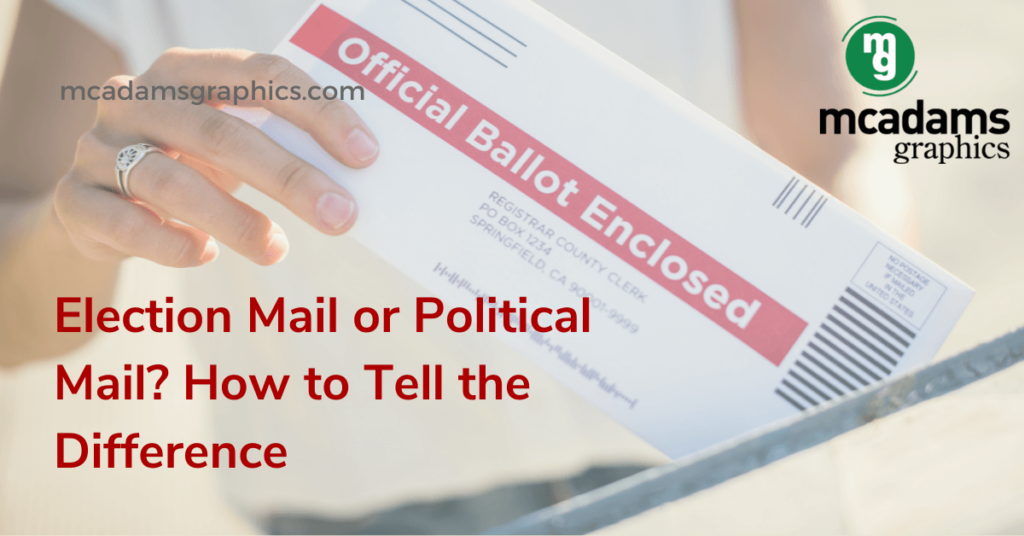
Election Mail or Political Mail? How to Tell the Difference
If it seems like there’s always an upcoming election in the United States, you’re not wrong. Between school boards, city councils, mayors, state legislatures and governors, and federal representatives, American voters head to the polls often, some years even multiple times.
Years like 2024 are banner election years. Presidential primaries begin in January and are held on a staggered basis into June, followed by the presidential election on Tuesday, November 5. All 435 seats in the U.S. House of Representatives and about one-third of the Senate seats are also up for election this year. Local and state elections typically take place every two to four years as well. (Check out Vote411.org to find the election information you need.)
Knowing this, we can all expect an influx of election-related direct mail this year! For candidates looking to get elected for the first time or to remain in office, it can be difficult to stand out – not just from their direct competitors but from all the other candidates running this cycle.
Though “election mail” and “political mail” seem like interchangeable terms, they’re actually two different categories of direct mail. In this blog, we’ll explain their differences and dive into political mail–why it’s important for political campaigns and how candidates can effectively use it to reach and sway voters.
The Differences Between Election Mail and Political Mail
Though some might use “election mail” and “political mail” interchangeably, it’s crucial to understand their distinct meanings because of their impact on the democratic process.
Election Mail
Election mail refers to a category of mail specifically designed to facilitate the electoral process by providing accurate and essential information to voters. Any mail sent to or from authorized election officials would be considered election mail and should bear the Official Election Mail Logo to distinguish it from political mail.

To ensure the integrity, security, and fair conduct of elections, election mail is subject to regulations, which vary at different levels of government (local, state, and federal).
Examples of Election Mail:
- Absentee or Vote-by-Mail Ballots
- Voter Registration Materials
- Polling Place Notifications
- Election Officials’ Correspondence
- Official Election Information and Guides
- Ballot Tracking Notifications
- Provisional Ballot Notices
- Military and Overseas Voter Materials
Political Mail
Because political mail is a much broader category of mail encompassing mailings related to political campaigns, advocacy, and public affairs, it’s divided into two subcategories: Political Campaign Mail and Political Message Mail.
According to the United States Postal Service, Political Campaign Mail is sent by registered political candidates, campaign committees, or political party committees for campaign purposes. The purpose of this type of mail is to “promote political candidates, referendums, or political campaigns.” Political Message Mail, on the other hand, is sent by political action committees (PACs), advocacy groups, or organizations engaged in “get-out-the-vote” efforts.
It’s important to note that political mail comes from a wide range of sources with varying agendas and intents. As such, political mail content can range from informational to persuasive or even controversial. The regulation of political mail and disclosure requirements for campaign financing vary based on local, state, and federal laws.
Examples of Political Campaign Mail:
- Campaign Flyers and Brochures
- Candidate Endorsement Letters
- Fundraising Appeals and Contribution Requests
- Campaign Merchandise Catalogs
Examples of Political Message Mail:
- Party Platform Statements
- Issue Advocacy Materials
- PAC Communications
- Voter Guides and Scorecards
- Advocacy Postcards and Letters
- Political Surveys and Polling Materials
Both election mail and political mail are important to America’s democracy and electoral process but for different reasons. Now that we know how to tell them apart, let’s discuss why direct mail is an essential part of political campaigning.
Why Political Campaigns Need Direct Mail
Running a political campaign is a multifaceted and strategic process involving many people and moving parts. Success is being elected, and for that to happen, candidates need money, name recognition, differentiation from opponents, visibility and credibility, and an active support base.
Political advertising campaigns across television, radio, print, and digital media help with all these areas, but direct mail is especially beneficial. A majority of voters surveyed after the 2022 Midterm Elections stated that direct mail is informative, educational, persuasive, and recallable–all things you want as a political candidate.
Statistics aside, compared to other forms of advertising, direct mail is cost-effective, targetable, and personalized so campaigns get a higher return for their print ad spend.
Cost-Effective
TV and radio advertising can quickly take up a large portion of a candidate’s advertising budget because the price varies based on media type, production costs, the size and location of the audience, timing and programming, duration and frequency, and more.
Direct mail, however, allows campaigns to control costs more predictably. Printing and postage costs are generally fixed, making it easier for campaigns to plan and manage their budget without unexpected fluctuations.
Campaigns can also manage the price by sticking with certain formats to save on printing and postage. Additionally, the ability to target stops campaigns from sending mail pieces to voters outside their audience.
Targetable
Direct mail allows campaigns to target specific demographics, neighborhoods, or voter segments. This targeted approach ensures that campaign materials reach the most relevant audience, minimizing waste and maximizing impact.
Personalized
Personalized direct mail, addressed to individual voters, can create a more personalized connection. This level of personalization is often more effective than generic messaging and can be achieved without the high costs associated with one-on-one canvassing or phone banking.
Based on the results of the United States Postal Service and the American Association of Political Consultants (AAPC) voter research, the majority of White, Black, Asian, and Hispanic voters find personalization important, but a smaller percentage of respondents in each group indicated they received personalized direct mail pieces.
Direct mail is an essential component of any political campaign’s ad mix and is necessary to reach voters, improve candidates’ recognition, and amplify their messages.
How to Make Your Direct Mail Campaign Stand Out During Election Season
Because so many political mailers are sent before elections, campaign communications teams must be strategic with their direct mail campaign strategy, design, and messaging. Here are our top eight guidelines to make direct mail campaigns stand out during election season.
-
Target Voters Using Data
Leverage data analytics to precisely target voters based on demographics, past voting behavior, and other relevant factors. By understanding the characteristics of your target audience, you can tailor your direct mail campaign for maximum impact.
-
Know and Understand Your Audience
Develop a deep understanding of your audience’s preferences, concerns, and priorities. This knowledge allows you to craft messages that resonate with their values, increasing the likelihood of engagement and support.
-
Use Messaging That Connects With Your Audience
Craft messages that speak directly to the concerns and aspirations of your audience. Effective communication is not just about what you say but how well you understand and address the needs of your constituents.
-
Connect Early and Often
Establish a consistent presence in voters’ mailboxes early in the campaign and maintain that presence throughout. Regular communication helps build familiarity and trust, making your campaign more memorable when it matters most.
-
Use Imagery That Portrays Trustworthiness
Choose visuals that convey trustworthiness and reliability. Whether it’s images of the candidate in community settings or symbols of trust, the right imagery enhances the credibility of your campaign.
-
Provide Help or a Service
Demonstrate your commitment to the community by offering valuable information or assistance. Whether it’s details about voter registration, community events, or other useful resources, providing a service builds a positive association with your campaign.
-
Use Large Postcards
Opt for larger postcards that stand out in the mailbox. Larger formats offer more space for impactful visuals and messages, increasing the chances that your mailer captures the attention of voters amid a sea of other mail.
-
Use a Clear Call to Action
Clearly communicate the action you want voters to take. Whether it’s attending an event, voting on a specific date, or contributing to the campaign, a clear and compelling call to action motivates voters to engage actively with your campaign.
By integrating these tips into your direct mail strategy, you enhance the effectiveness of your campaign communications. Targeted, well-crafted messages that resonate with your audience, combined with strategic use of imagery and a clear call to action, contribute to a memorable and impactful direct mail campaign during the election season.
Conclusion: Crafting Victory Through Direct Mail Mastery
A well-executed direct mail strategy is a formidable weapon in a political candidate’s arsenal. As we recap the key strategies outlined in this guide – from targeted data utilization to compelling imagery and clear calls to action – it’s crucial to recognize that adaptability and continuous improvement are the cornerstones of success. Political landscapes shift, and voter sentiments evolve, making it imperative for campaign teams to embrace flexibility and refine their approach. Direct mail, when leveraged effectively, transcends the clutter, fostering direct connections with constituents.
As candidates embark on their campaigning journey, we encourage them to harness the power of direct mail, not just as a means of communication but as a dynamic tool for shaping perceptions, building trust, and ultimately, securing victory at the polls.
Partner with McAdams Graphics for unparalleled direct mail solutions that capture attention, resonate with voters, and drive candidate success. Let’s craft a winning strategy together – because every message matters, and every vote counts. Learn more about how our printing and mailing services can lead to political success.

